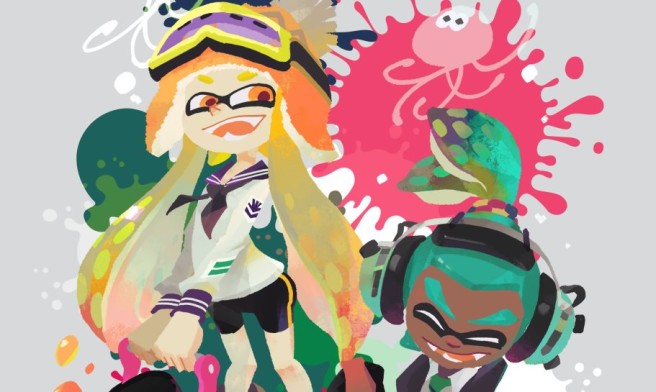Splatoon devs share background info on stages, talk about the end of updates, more
This week’s issue of Famitsu has more coverage of Splatoon. There isn’t any news about the game itself (which was to be expected), but there is a 4-page interview with the game’s developers. Famitsu caught up with producer Hisashi Nogami plus co-directors Tsubasa Sakaguchi and Yusuke Amano. They shared some interesting background information about stages, spoke about the end of updates and why they’re coming to a close, and more.
There is quite a bit here, so let’s get right to it. Head past the break for a summary of the interview.
– Most of the stages in Splatoon are based on marine products, but only Under Deca Line Girder Bridge (Urchin Underpass) isn’t. It’s based on Jujo Road, an actual road in Kyoto which is nearby Nintendo’s office. The ? kanji means ten, which can also become Deca in Greek. And ? means line, hence Deca-Line. Deca-Line is the name of the highway, and this stage is right underneath it, hence the “Under”.
– How the Deca-Line stage came to be included: art director Seita Inoue has a habit of sketching things nearby him. One day he drew a night view seen from the company building. When the development team was thinking about stage designs, they happened to find this sketch, and since it fitted many of the stage designs, it got picked. They were looking for a place with a realistic sense that has an origin of grey-toned neutral color and could be vandalized with colors.
– Looking back at when Splatoon was in its early reveals, which in Japan the first demo was available on Tokaigi 2015 in late January. They were quite nervous at first because they wondered what kind of gamers would come visit them. So when they set up a “Real Splatoon” corner which had actual water guns filled with ink, there were many people who lined up to try it out, and more people also watched with huge interest, so they were relieved.
– Then there was also the Internet demo that was available in May. The reactions to this were also great, and their Twitter followers, which was 25,000 before this event, also doubled thanks to this.
– After that they also talked about the Splatoon Koshien tournament in Japan. They noticed there were more people using the Splatterscope after the tournament.
– Why they had to differentiate between Regular and Ranked Matches: Regular is for a more casual play, while Ranked is for a more serious, hardcore play with records on the stake.
– Recently there’s been a habit with Japanese players where after the end of a battle, they do some sort of thing and put names on it. For example, “Eternal Phalanx Omega” is where a whole team put up a barrier, or “Final Crystal Dust” where everyone shoots tornadoes. But the team says that’s just the players getting carried away, because it’s a habit in Japanese children to give names to certain activities done in pastime.
– All stages are located in the vicinity of Haikara City / Inkopolis. Saltspray Rig and Bluefin Depot are quite far away but are both reachable by train. When asked if there is a whole map of Inkopolis, the staff said they have a rough sketch version.
– They also just announced 2 new stages: Piranha Pit and Ancho-V Games. They’re just recently done and both of them will be gimmicky stages. These stages will be very narrow, so they’re expecting new, unusual play styles to appear here.
– In November’s Nintendo Direct it was mentioned that Splatoon updates would continue only until January. To further elaborate on this, updates that add rules, stages, weapons, gear, etc. will have the last batch in January 2016. But after January they still will adjust weapons for balance if needed. Events like Splatfests will also continue to be held for the foreseeable future.
– When asked for a reason why they would stop adding new things, the team says because right now there are already 14 stages and over 70 kinds of weapons. So if they add even more, it would be hard for players to memorize all of them, especially when considering weapon compatibility with stages.
To close out, Famitsu asked about what we can expect from Splatoon going forward. Nogami mentioned that the team was anxious as to how the game would turn out, given its new IP status. However, thanks to those who played it, the title received “a certain amount of recognition, so I think we have to keep that pace as best as we can from hereafter.”
After Famitsu brought up interest in playing the sequel, Nogami closed out with the following:
“Thank you for saying that. We can really feel the reaction from Japanese users to a degree, but recently we can also feel that people from outside Japan are also accepting this, so we’re really glad.”
Thanks for making it to the end of this post! If you use any of this translation, please be sure to properly source Nintendo Everything. Please avoid copying its full contents if possible.
